Planning a safari isn’t like packing for a typical vacation. The landscapes are wild, the logistics are unique, and what you bring can shape your entire experience. That’s why creating a smart packing list for African safaris is essential—comfort, safety, and even wildlife encounters depend on what you wear and carry.
From early morning game drives to sundowners by the fire, this guide helps you build a tailored packing list for African safaris with practical tips, personal insights, and expert advice. Whether you’re heading to the Serengeti or the Okavango, the right gear ensures you stay present for every thrilling moment.
Table of Contents
Pre-Departure Checklist
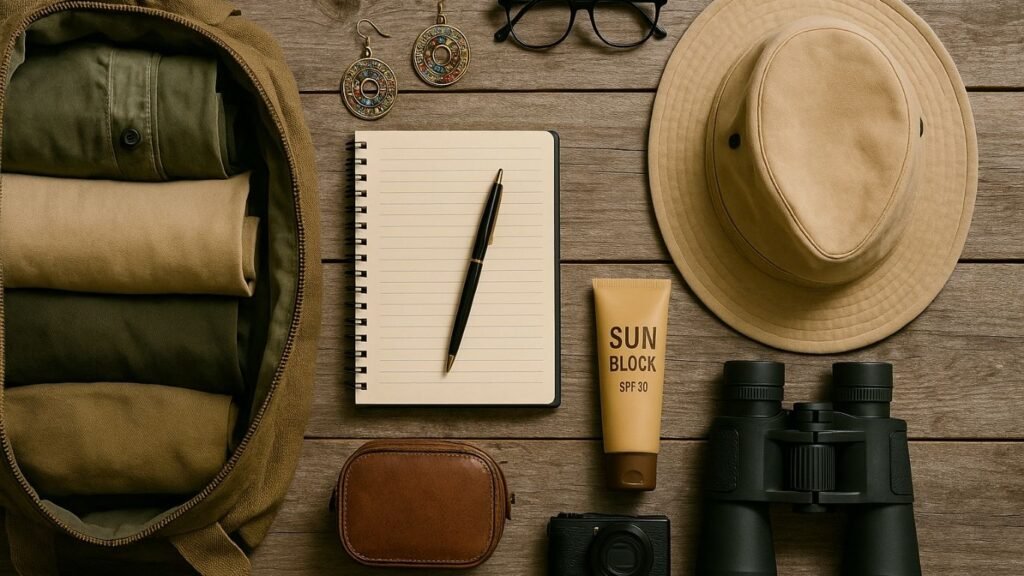
Before you even unzip your suitcase, building the right packing list for African safaris starts with preparation at home. This is the behind-the-scenes work that ensures smooth travel, seamless border crossings, and peace of mind. Without a thorough pre-departure checklist, even the most carefully curated packing list for African safaris can fall short when you’re deep in the bush with no pharmacy or photocopier in sight.
Travel Documents
Start with the essentials. Ensure your passport is valid for at least six months beyond your travel dates, with multiple blank pages for visa stamps. Double-check visa requirements for each country you’re visiting and confirm if your itinerary includes transit through any others. Print out copies of your passport, visas, and itinerary—these should be included in your packing list for African safaris folder.
Vaccinations and Health
Visit a travel health clinic 4–6 weeks before departure. Common recommendations for safari-goers include yellow fever, hepatitis A, typhoid, and rabies (depending on location and duration). Malaria prophylaxis is often necessary, especially in areas where mosquitoes are prevalent. Your packing list for African safaris should also include a printed vaccination card, any prescription medications, and a mini health kit.
Financial Readiness
While many safari lodges operate on an all-inclusive basis, gratuities, curios, and snacks often require cash. Include clean, recent U.S. dollar bills in small denominations as part of your packing list for African safaris, along with a credit card for emergencies. Notify your bank of your travel plans to avoid blocked transactions.
Travel Insurance
Comprehensive travel insurance isn’t just a smart idea—it’s essential. Your packing list for African safaris should include a hard copy of your insurance policy, proof of coverage for medical evacuation, and a list of emergency contacts. If you’re going to remote areas, verify that your provider covers those regions.
Communication & Backup
Save copies of your itinerary, contact details for your safari operator, and emergency numbers both digitally and in print. Consider downloading offline maps and translation apps. A paper copy of your entire packing list for African safaris and relevant bookings can be invaluable if devices fail.
This checklist sets the tone for a trip that feels effortless—because you’ve done the work in advance. Your packing list for African safaris isn’t just about clothes and gear; it begins with preparation that protects your time, your health, and your experience.
What to Wear: Clothes to Pack
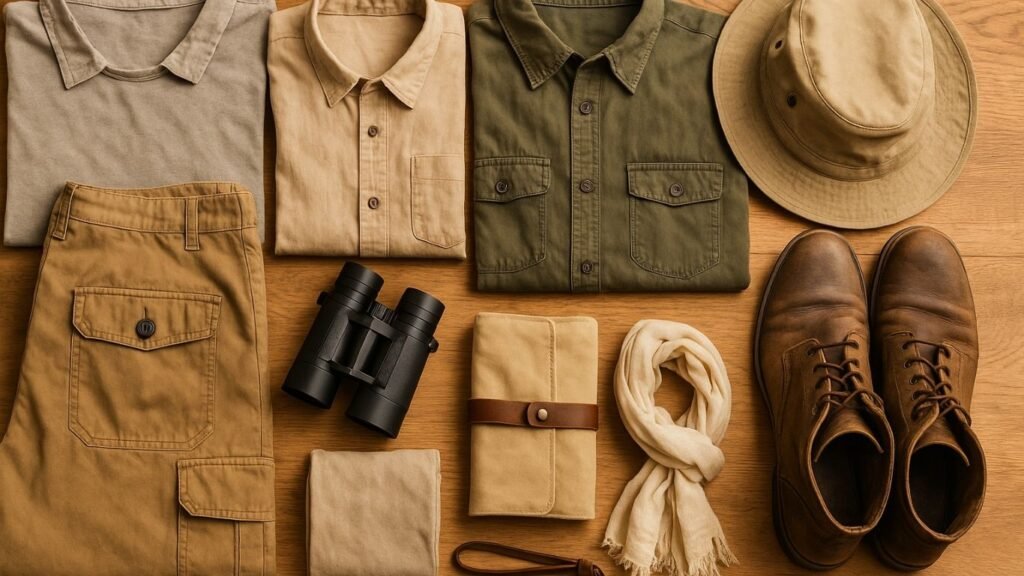
When it comes to creating the perfect packing list for African safaris, what you wear is almost as important as what you see. Safari fashion isn’t about aesthetics—it’s about function, protection, and blending into the environment to avoid attracting unwanted attention from both bugs and wildlife.
Choose Earthy, Neutral Colors
The best clothing for your packing list for African safaris comes in shades of khaki, olive, brown, and beige. These tones don’t just look safari-appropriate—they help you stay inconspicuous during game drives and walking safaris. Avoid white (which gets dirty quickly), black (which absorbs heat), and blue (which attracts tsetse flies).
Lightweight Layers for Unpredictable Weather
African safaris often involve chilly mornings, hot afternoons, and cool evenings. Your packing list for African safaris should include long-sleeved, breathable shirts made from moisture-wicking fabrics, as well as convertible trousers that zip off into shorts. A lightweight fleece or insulated jacket is essential for early game drives.
Rain and Wind Protection
Even in dry seasons, sudden showers can catch you off guard. A windbreaker or packable rain jacket should absolutely earn a spot on your packing list for African safaris, especially if you’re visiting places like Zambia or Uganda where rain is unpredictable.
Footwear for All Terrain
Your packing list for African safaris should include one pair of closed-toe hiking shoes or trail runners—durable enough for bush walks, but comfortable for all-day wear. Add a pair of sandals or slip-ons for downtime at your lodge or camp.
Accessories That Work Overtime
Don’t forget a wide-brimmed hat with a chin strap for sun protection and to keep it secure during open-vehicle rides. Polarized sunglasses help reduce glare during water-based safaris, while a scarf or buff can block dust and double as a headwrap or light cover-up. These items might seem small, but they earn big value on any packing list for African safaris.
Comfort, camouflage, and climate control—these are the guiding principles for any smart packing list for African safaris. If your clothing keeps you protected, cool, and comfortable, you’ll spend less time fidgeting and more time spotting leopards in the treetops or elephants crossing riverbeds.
Sun & Bug Protection: Non-Negotiables
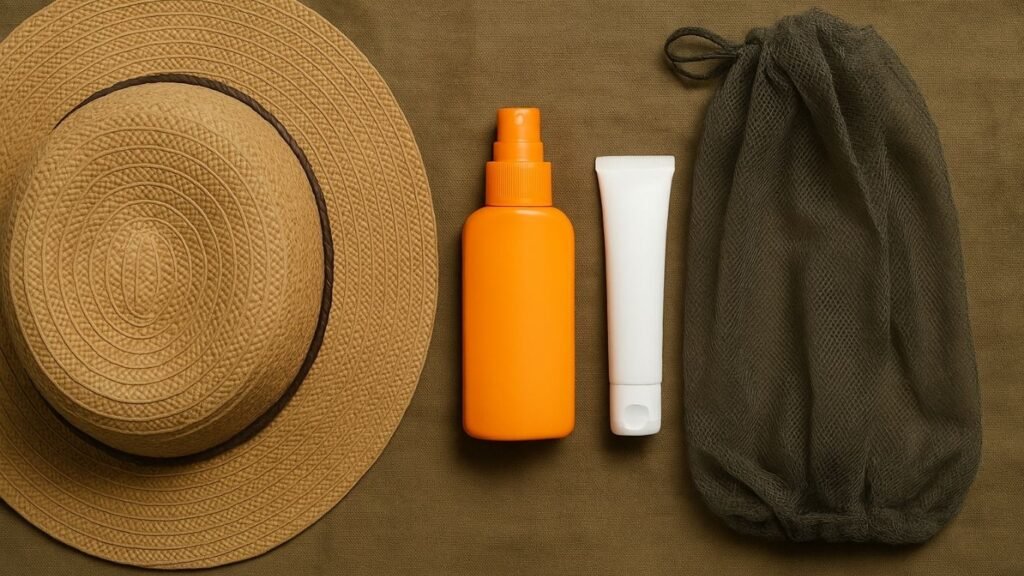
The African sun doesn’t hold back—and neither do its insects. Every smart packing list for African safaris must prioritize protection from both. It’s not just about comfort; it’s about health, safety, and keeping your focus on the wildlife rather than battling sunburn or mosquito bites.
Sunscreen Is Essential
This one’s non-negotiable. The sun on safari—especially in high-altitude areas like the Ngorongoro Crater or Namibia’s deserts—is intense. Choose a high-SPF, broad-spectrum sunscreen and reapply throughout the day. It should go at the top of your packing list for African safaris, right alongside your toothbrush.
DEET-Based Insect Repellent
While not glamorous, insect repellent is a safari essential. Mosquitoes can carry malaria, and tsetse flies—prevalent in parts of Tanzania and Zambia—deliver painful bites. Your packing list for African safaris should include a repellent with at least 20–30% DEET, or opt for natural alternatives like lemon eucalyptus oil if you’re sensitive to chemicals.
Treated Clothing for Extra Protection
For added peace of mind, include insect-repellent clothing in your packing list for African safaris. Brands like Insect Shield offer shirts, pants, and buffs that are pre-treated with permethrin—effective against mosquitoes and ticks. These pieces provide long-lasting protection and reduce the need for constant repellent reapplication.
Sun-Protective Accessories
Wide-brimmed hats, UV-rated sunglasses, and lightweight scarves aren’t just for style—they’re crucial components of your packing list for African safaris. A breathable, long-sleeved shirt also provides dual protection from UV rays and bug bites without weighing you down in the heat.
Mosquito Nets and Plug-in Devices
Some lodges provide nets, but it’s always wise to bring a compact, travel mosquito net if you’re venturing into remote or budget accommodations. Plug-in mosquito repellents or wearable repellent bracelets are additional smart items for your packing list for African safaris—especially during the evenings.
A thoughtful packing list for African safaris doesn’t just get you through the day—it keeps you healthy enough to enjoy every single minute. The wild is waiting, but it’s best appreciated bite-free and burn-free.
Essential Safari Gear & Accessories
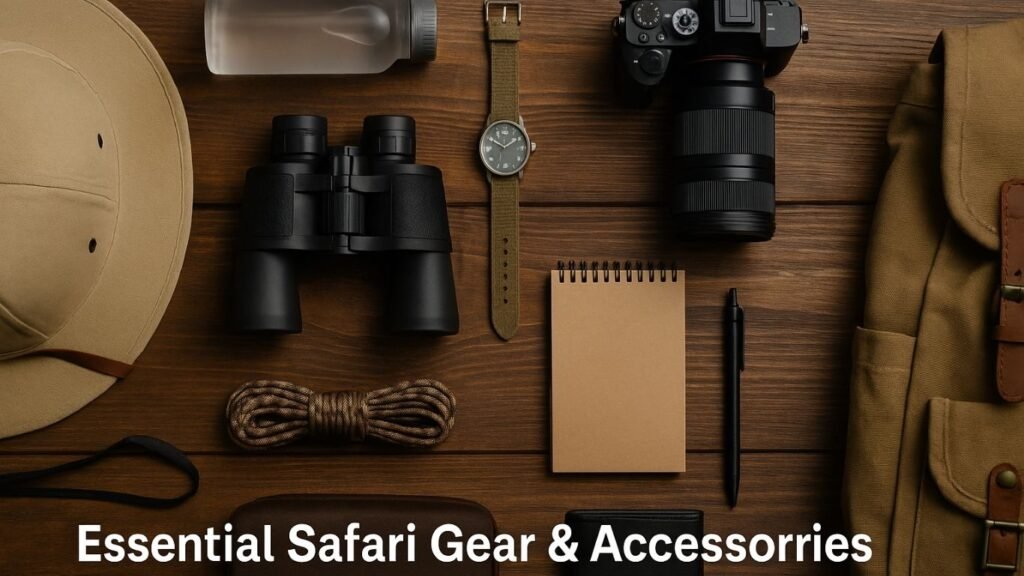
Every seasoned traveler knows that success lies in the details. On an African safari, that means packing gear that’s versatile, durable, and purpose-built for the wild. Your packing list for African safaris isn’t complete without these core essentials—tools that ensure you don’t just survive the bush, but thrive in it.
Binoculars: Your Safari MVP
Wildlife doesn’t always stroll up to your vehicle. A quality pair of binoculars is one of the smartest additions to any packing list for African safaris. Choose something lightweight but powerful—ideally with 8x or 10x magnification—so you can spot that elusive leopard in the treetops or track a pride of lions across the plains.
Camera Equipment
Photos will outlive the dust and adrenaline of your trip. Include a DSLR or mirrorless camera in your packing list for African safaris, along with a zoom lens (200mm+ is ideal), spare memory cards, and batteries. A lens cloth is also essential—bush dust finds its way into everything. Don’t forget: silence your shutter in close encounters to avoid startling animals.
Daypack: Small but Mighty
Whether it’s a morning game drive or a full-day excursion, a lightweight backpack should be part of your packing list for African safaris. Use it to carry water, sunscreen, snacks, your camera, and a field guide. Look for one with padded straps and water-resistant material to handle any terrain or weather.
Reusable Water Bottle
Hydration is critical, especially in dry or high-altitude regions. A reusable water bottle with good insulation should top your packing list for African safaris. Some lodges offer filtered water stations—refill instead of relying on disposable plastic, which is banned in several African countries.
Flashlight or Headlamp
Electricity can be limited or inconsistent in some lodges. A headlamp or small flashlight belongs on every packing list for African safaris, especially if you need to navigate between tents at night or pack in the early morning.
First Aid Kit
Your packing list for African safaris should include a compact but complete first aid kit: adhesive bandages, antiseptic wipes, anti-inflammatory medication, rehydration salts, and any personal prescriptions. In remote areas, even a blister can become a trip-ruiner without proper care.
These core items elevate a good packing list for African safaris into a great one. They’re not luxuries—they’re lifelines that support comfort, preparedness, and presence. Because on safari, every sense matters, and the right gear helps you focus on the wild wonders unfolding around you.
Useful Extras & Nice-to-Have Items
While your core gear and clothing make up the backbone of your packing list for African safaris, it’s often the small, thoughtful extras that elevate your experience from great to unforgettable. These aren’t must-haves in a survival sense—but they’re the kind of items that make long days smoother, downtime more comfortable, and the overall journey more rewarding.
Travel Journal or Safari Log
Safaris are sensory overload—in the best way. You’ll want to capture not just the animals you see, but the emotions and moments that made your trip special. Include a small journal in your packing list for African safaris so you can jot down wildlife sightings, guide stories, or those sunset reflections around the campfire.
Wildlife Field Guide or Mobile App
A field guide to African mammals or birds adds richness to every game drive. Include one in your packing list for African safaris to better identify the difference between a hartebeest and a topi or learn why certain birds follow buffalo herds. Alternatively, download a reputable offline app before you go.
Power Bank and Charging Cables
Most camps offer limited electricity or charging time, especially in eco-lodges that rely on solar power. Add a fully charged power bank to your packing list for African safaris, along with cables for all your devices. It ensures your camera, phone, and e-reader stay alive when the action heats up.
Travel Pillow, Eye Mask, and Earplugs
Long flights, dusty roads, and open-roof vehicles can leave you craving rest at odd hours. These compact comfort items are a clever addition to your packing list for African safaris, especially if your itinerary includes overland transfers or bush flights.
Compact Snacks
Safari schedules can be unpredictable—sometimes wildlife keeps you out longer than expected. Including a stash of protein bars, trail mix, or electrolyte gummies in your packing list for African safaris helps you stay energized between meals without needing to dig into your lodge’s supplies.
Ziplock Bags and Dry Bags
Whether it’s protecting your electronics from dust or keeping your used laundry separated, resealable bags are a surprisingly useful part of any packing list for African safaris. For wetter destinations like the Okavango Delta or Victoria Falls, bring a dry bag too.
These nice-to-have items won’t take up much room, but they offer outsized benefits when you’re in the middle of nowhere. A little extra thought goes a long way—especially when your packing list for African safaris is built not just for survival, but for deeper connection, comfort, and discovery.
What NOT to Pack
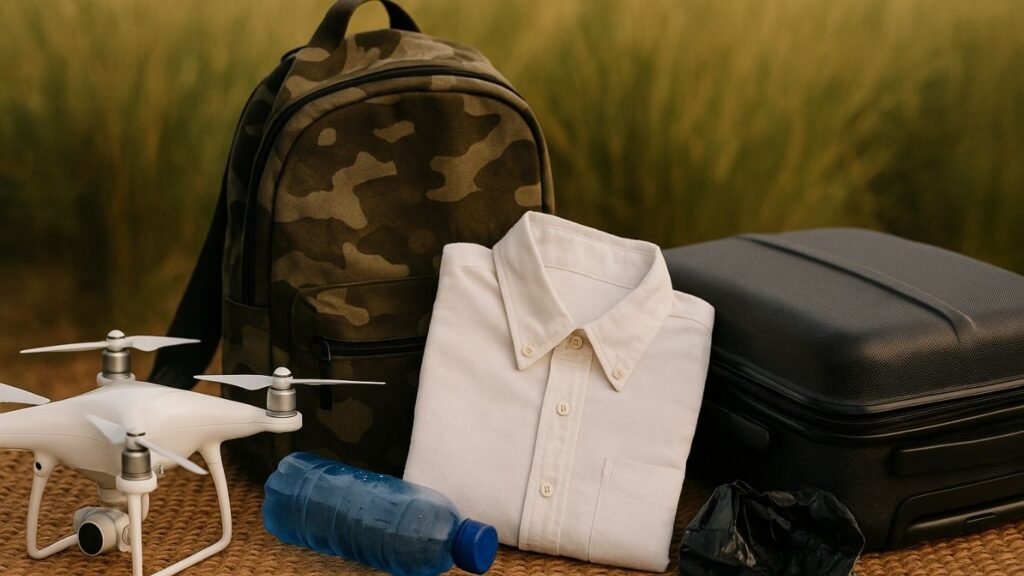
Just as important as knowing what to bring is knowing what to leave behind. A well-curated packing list for African safaris isn’t about bringing more—it’s about bringing smart. Extra baggage isn’t just inconvenient; it can also break local laws, disrupt wildlife, or weigh you down with unnecessary items. Here’s what your packing list for African safaris should absolutely exclude.
Camouflage Clothing
Despite being outdoorsy, camouflage prints are often associated with military personnel in many African countries. Wearing them can lead to misunderstandings or even legal trouble. Your packing list for African safaris should lean toward neutral earth tones—khaki, beige, olive—not military-style prints.
Bright or White Clothing
While that white linen shirt might look great in photos, it’s not practical on safari. Bright colors stand out against the natural environment and can scare off wildlife. Worse, white clothing attracts dust and dirt within minutes. A clean, subdued color palette should dominate your packing list for African safaris.
Plastic Bags
Many African nations—including Kenya, Rwanda, and Tanzania—have banned single-use plastic bags outright. Possessing them, even in your luggage, can result in fines or confiscation. Instead, opt for reusable cloth or silicone pouches for organizing items within your packing list for African safaris.
Drones
Tempting though it may be to capture sweeping aerial shots, drones are banned in nearly all national parks and reserves. Their noise disturbs wildlife and violates park regulations. If you’re building a responsible packing list for African safaris, leave drones off it unless you have rare, written, official clearance.
Unnecessary Electronics
Unless you’re a wildlife photographer or digital nomad, you don’t need multiple devices. Avoid the stress of charging and safeguarding extra gadgets. A streamlined packing list for African safaris might include just your phone, camera, and e-reader—with backups for each.
Excessive Toiletries
You won’t need full-size shampoo bottles or four kinds of body lotion. Lodges often provide basic amenities, and you’ll likely spend most of your time outdoors anyway. Pare down your toiletry kit as part of a lean, efficient packing list for African safaris.
By trimming the excess and focusing on what truly adds value, your packing list for African safaris becomes a tool of clarity—not clutter. Pack what you need, respect the environment, and travel lighter—both physically and mentally.
Gifts & Donations

A thoughtful packing list for African safaris isn’t limited to what serves your journey—it can also reflect how you give back. Many travelers feel inspired to contribute to the communities they encounter on safari, and with a bit of planning, your suitcase can carry more than just personal essentials—it can carry impact.
Be Informed, Not Impulsive
Before adding gifts or supplies to your packing list for African safaris, consult your safari operator or local guide. They know the communities intimately and can advise on what’s genuinely helpful versus what may be culturally inappropriate or duplicative.
Educational Supplies
Schools in rural safari regions often lack basic materials. If you’re including donations in your packing list for African safaris, consider items like pencils, notebooks, crayons, solar calculators, and chalk. Avoid heavy books unless you know there’s a need.
Hygiene Products
Toothbrushes, toothpaste, menstrual hygiene items, and soap are deeply appreciated in many communities. These make excellent additions to a packing list for African safaris if you’re planning to visit or support local villages or health posts.
Children’s Clothing
Many children in safari regions attend school barefoot or with worn-out clothes. Lightweight garments, gently used shoes, or even soccer jerseys are great to include in your packing list for African safaris—especially in smaller sizes.
Avoid These Items
Don’t bring sweets or candy. While well-intentioned, sugary gifts can cause health issues and create dependency or disruption. Also skip anything that assumes Western preferences, like toys needing batteries or English-language storybooks without local relevance. Your packing list for African safaris should be humble, respectful, and tailored to local needs.
Give Through the Right Channels
If possible, deliver donations through trusted local NGOs, community coordinators, or school officials. This ensures dignity and equitable distribution, aligning your packing list for African safaris with sustainable practices.
Incorporating gifts into your packing list for African safaris is a meaningful gesture—but only when done with awareness and respect. What you give matters. How you give it matters more.
Safari Packing Tips & Luggage Restrictions

The wild doesn’t care about your suitcase, but your bush plane pilot definitely does. When curating your packing list for African safaris, understanding luggage restrictions and smart packing strategies isn’t optional—it’s essential. Unlike typical vacations, safaris often include small aircraft transfers and remote lodges where baggage capacity is limited, and convenience is hard to come by.
Choose the Right Bag
Forget the hard-shell roller case. Most safari operators recommend soft-sided duffel bags, which are easier to stow in safari vehicles and tiny aircraft cargo holds. Your packing list for African safaris should start with a soft, flexible bag—preferably without rigid frames or wheels.
Know the Weight Limits
Bush planes don’t just recommend weight limits—they enforce them. In most cases, travelers are allowed between 15 to 20 kilograms (33 to 44 pounds), including carry-on. That’s why a disciplined, lightweight packing list for African safaris is crucial. Overpacking may require you to purchase an extra seat or leave items behind.
Use Packing Cubes
To stay organized and maximize space, include packing cubes or compression bags in your packing list for African safaris. Group clothing by type or day, and store toiletries and electronics in separate compartments. It makes repacking between camps quick and frustration-free.
Bring a Lightweight Daypack
Many travelers forget this item in the excitement of prepping their main luggage. But a daypack is a must on any well-structured packing list for African safaris. Use it to carry daily essentials like sunscreen, binoculars, camera gear, and snacks while on game drives or walking safaris.
Layering Over Quantity
Because laundry services are often included at safari lodges, you can pack fewer items and re-wear clothing. Your packing list for African safaris should focus on breathable, quick-drying layers that serve multiple functions. One fleece can work for both chilly mornings and cold evening sundowners.
Label Everything
In shared luggage holds or small airstrips, things get moved, shifted, and occasionally mixed up. Label every bag, including your daypack and camera case. Your packing list for African safaris should reflect a traveler who’s prepared—not just packed.
By following these tips, your packing list for African safaris transforms from a checklist into a precision strategy. When you pack smart, you travel light, and when you travel light, you move through the wild with confidence and ease.
Making the Most of Your Safari: Respecting Wildlife and Local Cultures
An African safari is more than a trip—it’s a transformative journey into landscapes shaped by time and tradition. While building your packing list for African safaris is about practicality and preparation, it also reflects your attitude toward the places and people you encounter. To truly make the most of your safari, pack not just gear, but a mindset rooted in respect.
Respecting Wildlife: Be a Quiet Observer
The animals you’ll see are wild, and their survival depends on a delicate balance with their environment. Your packing list for African safaris helps you observe without disturbing: binoculars allow you to watch from a distance, neutral-colored clothing helps you blend in, and silent cameras keep the moment intact.
- Don’t Stand Up or Move Suddenly during game drives—animals perceive these actions as threats.
- Avoid Flash Photography, which startles animals and can even endanger them.
- Never Feed the Wildlife. Your snacks, even if well-intentioned, disrupt natural behaviors.
Every item you include in your packing list for African safaris, from a quiet camera shutter to a dust-colored shirt, can play a role in minimizing your footprint in the animal kingdom.
Respecting Local Cultures: Travel as a Guest
Africa isn’t just home to wildlife—it’s home to people, cultures, and communities rich in history and tradition. A thoughtful packing list for African safaris should also take this human element into account.
- Dress Modestly in Villages or Towns. Even if you’re transitioning from a game drive, bring a shawl or wrap to show cultural sensitivity.
- Ask Permission Before Photographing Locals. Your respect is as important as your lens.
- Support Local Artisans by purchasing crafts directly and avoiding mass-produced trinkets.
- Listen to Guides and Elders, whose stories add richness to the experience and context to the land you’re exploring.
When you build a packing list for African safaris with intention and cultural awareness, it becomes more than a travel plan—it becomes a form of respect. From safari etiquette to local engagement, your gear, behavior, and attitude should work together to honor both the natural world and the people who live alongside it.
A safari isn’t just about what you see—it’s about how you show up. Let your packing list for African safaris be a reflection of curiosity, humility, and the privilege of stepping into wild, sacred spaces.
4 Unmissable Budget Wildlife Safari Experiences
